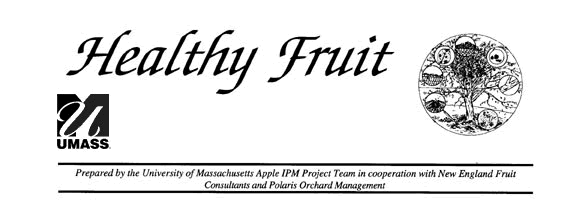
|
|
|---|
Leaf analysis is the only accurate means of assessing nutrient needs of fruit trees, since it measures the actual quantity of nutrient elements that is able to make it into the tree. It is time to begin collecting samples.
General Procedures:
For Assessment of General Nutrient Status:
To Diagnose Problems:
In mid to late July, it is not unusual to see buildup of Japanese beetles in orchards. This season is no exception, as moderate populations of feeding and mating JB have been observed in many orchards over the past week.
JB adults are generalist foliar feeders and can damage nearly all plants commonly in and around orchards. Casual field observations reveal that where there is one JB feeding on foliage, there generally are many more—often wrestling in a big mass. Indeed, JB adults are drawn to trees where other beetles are feeding, which leads to highly aggregated damage. Because of the aggregated nature of JB feeding, damage is generally most severe on young or high-density trees, and is rarely a major concern in larger, mature plantings. However, aggregation of JBs into small sections of an orchard also makes for easier treatment; localized populations and apparent damage make for easily timed, well-targeted treatment.
If JB build to unacceptable levels (particularly on young trees), a treatment of Sevin should offer good control, while allowing a short preharvest interval.
Low levels of woolly apple aphid infestation have been observed in most orchards, evidenced by white, fluffy protrusions from watersprouts and pruning cuts. In all monitored sites, the visual evidence of WAA infestation is not alarming—unfortunately, there is some question toward the accuracy of using above-ground evidence of WAA as an indicator of a damaging population. Studies in the past 5 years indicate that there is no direct correlation between the visible population and the level of subsurface (directly damaging) infestation. However, the above-ground population can certainly make a mess in the canopy, as drizzle from the sugary honeydew excreted by WAA offers an ideal site for development of sooty mold fungus on leaves and fruit.
With the potential for in-canopy WAA damage to fruit quality, we recommend a provisional treatment threshold of 50% infestation of pruning cuts. If treatment against WAA is necessary, a half-rate of Thiodan should suffice to clear up the risk of further damage.
Most orchards remain relatively free of major leafminer problems, which is certainly a relief given the apparent challenges of treating this season’s second generation. Weather conditions during flight of first-generation LM adults led to very inconsistent egglaying and subsequent larval development. This disparity in first-generation growth has carried directly into second-generation mines, as LM development stages are currently all over the map. However, it appears that the majority of second-generation mines remain as sap feeders, and growers may still see benefit from a second-generation treatment with Provado or SpinTor. Vydate and Lannate are also labeled options and, though not highly recommended, can offer control of more fully developed mines.
Despite early activity in a few unsprayed sites, samples over the past week have revealed a slow-starting apple maggot fly population in all (save one) monitored commercial orchards. Captures of AMF on unbaited red monitoring spheres average far below 1 per trap — suggesting that very few commercial
orchards are facing much immediate threat of AMF damage to mid- and late-developing cultivars. Additionally, only a few AMF stings have been observed this week (in samples of 5000 fruit)—we are indeed very early on in the AMF season. Given the currently low AMF pressure, very low rates of either Guthion or Imidan should offer effective AMF control as soon as unbaited trap captures exceed 2 or more AMF per sphere.
An update to last week’s Healthy Fruit article on the discovery of plum pox virus (PPV) in a Canadian peach orchard -- apparently the virus has also been found in trees other than those that came from Adams County Nursery. In fact, twenty composite samples from older peach trees in proximity to the infected Fantasia nectarine trees from Adams County were just recently found to be positive for the plum pox virus. These older trees are thought to have been originally propagated in Canada. Canadian agriculture officials have ordered the eradication of all Fantasia trees from the 1997 shipment wherein the previous three infected trees were found, as well as peach, nectarine, and plum trees within a 100 meter radius of the infected trees. They are still vigorously sampling stone fruit orchards for PPV in the Niagara peninsula region. Therefore, the PPV problem appears to be much more serious than originally thought in Canada, and the source of PPV infection in these trees is still undetermined. Stay tuned.
Healthy Fruit is written by Dan Cooley, Ron Prokopy, Jon Clements, Starker Wright, Arthur Tuttle, Wes Autio, Bill Coli, and Duane Greene except where other contributors are noted. Publication is funded in part by the UMass Extension Agroecology Program, grower subscriptions, and the University of Massachusetts IPM Program. A text version can be e-mailed to you if you contact Doreen York. Please cite this source if reprinting information.
Go to the UMass Extension Main Page
Return to the UMass Fruit Advisor Main Page
Return to the Healthy Fruit Index Page